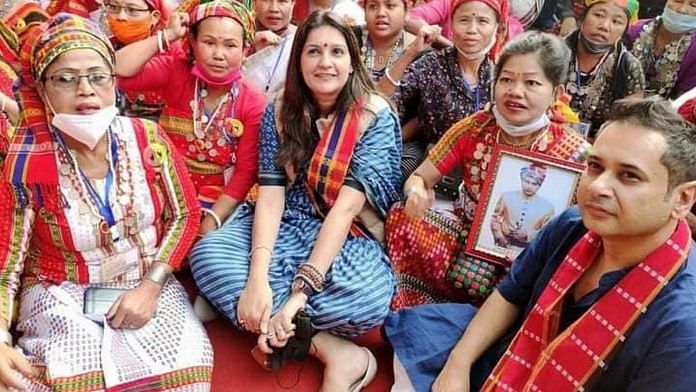Guwahati: Earlier this month, a crowd of at least 1,500 people, many of them in colourful traditional attire, gathered at Delhi’s Jantar Mantar for a three-day sit-in to demand the creation of a new state called Greater Tipraland for the indigenous people of Tripura.
The clamour for the new state is spearheaded by the Tipraha Indigenous Progressive Regional Alliance (TIPRA, also called Tipra Motha) and the Indigenous People’s Front of Tripura (IPFT).
The dharna in Delhi also saw visits from Congress, Shiv Sena, and Aam Aadmi Party (AAP) leaders, who said they would urge the central government to “consider” the creation of Greater Tipraland seriously.
The demand for a separate state for indigenous Tripuris (also known as Tiprasas or Tipras) is not a new one, and has been raised several times by the IPFT. However, ever since this outfit entered into an alliance with the ruling BJP in the state, these demands have become more muted.
Now, Tipra Motha president Pradyot Manikya Debbarma, a scion of the erstwhile royal family of Tripura, has revived the cause and become its new face.
The roots of the demand for a Greater Tipraland lie in the drastic demographic changes that have taken place in Tripura since the time of independence. The proposed state is also envisaged to include some areas beyond Tripura.
Also Read: Tripura mosque attacks: Ground report on what really happened
Where’s the demand coming from?
A landlocked state, Tripura shares a border with Bangladesh on the north, south and west. The state has seen several waves of Bengali migration, the largest being after Partition in 1947 and then in 1971 with the liberation of East Pakistan and the formation of Bangladesh.
In a 2019 paper published in the IOSR Journal Of Humanities And Social Science, researcher Gourishwar Choudhuri noted: “The tribal natives, who constituted a dominant 64 per cent of the total population in 1874, formed a reduced component of the population in successive Census enumerations… The tribals were pushed to the hills and the politics and administration came to be dominated by Bengali-speaking locals and migrants.”
The 2011 Census data indicated that the proportion of Tripura’s 19 scheduled tribes had dwindled to just 31.78 per cent of the population.
The shift in demographics led to the creation of several tribal outfits that have demanded self-determination and sovereignty.
One such group was the Tripura National Volunteers (TNV), which was formed around the time the state elected its first-ever CPI(M) government under Nripen Chakraborty in 1978. This group had demanded for Tripura’s independence from India, but eventually laid down its arms and refashioned itself as the Indigenous Nationalist Party of Twipra.
In 1985, the Tripura Tribal Areas Autonomous District Council (TTADC) was vested with executive and legislative powers under the Sixth Schedule of the Constitution, with the aim of providing internal autonomy to tribal areas and to provide social, economic, and cultural protection to the people.
The TTADC, which has occasionally been described as a “mini state assembly“, currently administers nearly 70 per cent of Tripura’s land area, but some regional outfits say that only separate statehood can protect the rights of the 19 Tripuri tribes.
What is Greater Tipraland and who is fighting for it?
The demand for a separate Tipraland was raised first by the IPFT, which was formed in 2009 under the tribal ideologue N.C. Debbarma. The vision at this time was to carve a separate state out of TTADC areas.
The new demand for Greater Tipraland, however, is not just for the TTADC-ruled regions, but also surrounding areas that have a sizeable Tripuri population.
The movement for separate statehood has gathered and lost steam intermittently over the years, but it received fresh momentum after Pradyot Debbarma — who was briefly the president of the Tripura Pradesh Congress Committee — floated TIPRA or Tipra Motha as a political party in February 2021 (it was launched in 2019 as a social organisation) and advocated for Greater Tipraland.
In the April 2021 elections to the TTADC, the Tipra Motha won 18 out of the 28 elected seats and the IPFT was routed, but both political outfits are currently united in their demand for Greater Tipraland.
According to the current demands, this proposed state should also include areas outside Tripura if they have a substantial Tripuri population. Greater Tipraland proponents, therefore, envision the new state enfolding parts of Assam, Mizoram, and even parts of Bangladesh border areas such as Chittagong and Bandarban.
Pradyot Debbarma has said in interviews that the “concept” of Greater Tipraland is not limited to TTADC areas, but should include every “indigenous area or village”.
He has also said that the struggles of the people of Tripura can be solved by the government under Articles 2 and 3 of the Constitution, which empower Parliament to establish new states.
(Edited by Asavari Singh)
Also Read: TMC instigating trouble in Tripura, is worse than Taliban, says Union minister Pratima Bhoumik



